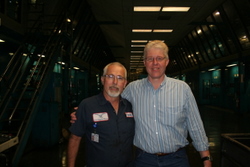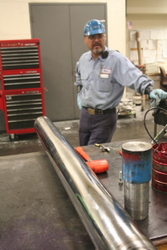 Newspapers have been called the “daily miracle.†The accomplishment of delivering a product of such remarkable breadth and complexity to hundreds of thousands of doorsteps by
Newspapers have been called the “daily miracle.†The accomplishment of delivering a product of such remarkable breadth and complexity to hundreds of thousands of doorsteps by
I never would have met Edward Padgett (left) if it weren’t for this blog. Ed publishes Los Angeles Times Pressmens 20 Year Club. It’s a blog about newspapers, the LA Times, Ed’s longtime buddies in the press room and anything else Edward Padgett wants to write about. Ed’s blog sends more traffic to Newspaper Death Watch than any other site on the Internet, including Google. Ed’s been online for more than 20 years, going back to Prodigy days. He’s very online-savvy.

Ed and I have been exchanging links for months, so my trip to LA was an opportunity to get together. For nearly two hours, he showed me around the massive Olympic Blvd. facility of the LA Times. It was a quiet day and the presses were idle. The guys on the early shift were mainly cleaning up, repairing equipment (the Times stopped doing preventive maintenance four years ago) and getting ready for the late-week insanity leading up to the Sunday edition.

The pressroom is a big place. The presses themselves stand about 20 feet high and stretch for a tenth of a mile. A giant storehouse on the first floor houses hundreds of 2,400-lb. rolls of newsprint, many of which arrive by rail cars that roll right into the warehouse. The newsprint rolls are fed by robotic forklifts to presses as they’re needed. The storeroom shown below doesn’t even hold enough paper for a single day’s edition.

Nearly everyone working the morning shift has known each other for a long time. Ed’s been at the Times for 36 years, but he’s not the most senior guy. John Miner (right) has been there for 37 years. He teaches new hires how to work the presses.
There’s a camaraderie to this crew that only comes from experience. These guys can practically finish each other’s sentences. In this age of outsourcing, we sometimes forget the value of having a workforce that instinctively knows what each other will do in any situation.
The pressmen’s commitment is to the newspaper and to each other. They’ve seen publishers and guys in suits come and go. The guys on the press always outlast the latest manager or the latest management fad. They’ll work their butts off to get the paper out, but they could mostly care less what some executive tells them to do. They’re as friendly with some of the reporters and editors as they are with each other. Ultimately, everyone who works for a newspaper knows that he or she is part of a large and intricate assembly line. The guys in the press room happen to be near the end.
Ed’s blog has an impact. Sam Zell checks it out regularly and even singled out Ed for recognition on a recent visit to the Times. Publisher David Hiller is also a reader. Los Angeles Times Pressmens 20 Year Club is a bit of a thorn in Hiller’s side because Padgett sometimes publishes internal memos or breaks news before it’s meant to be broken. The Times even had the lawyers look into shutting Padgett down at one point, but decided there was nothing they could do. So they enjoy a friendly but somewhat awkward truce. Ed won’t do anything to hurt the paper he loves, but he won’t pull his punches when he sees something wrong. He loves to spotlight LA Times critics like Jim Reich, whose scathing commentaries are a must-read. Hiller has evidently learned to live with it, because he and Ed are on a first-name basis.
Ed gave me a book of Times sports pages and a book of dessert recipes written by a Times staffer as a parting gift. I’m sure we’ll meet again. He is a class act, and so are the other 20-year guys I met, whose pressroom wizardry helps pull off that daily miracle.
More photos below.

Padgett on press

Newsprint in storage

Spent rolls awaiting recycling



 Your obedient editor is on cloud nine this morning, having been on hand in Fenway Park last night to witness a no-hitter by Red Sox lefty Jon Lester. It took 39 years of attendance at hundreds of games in New York, Boston and several other cities in North America, but the thrill was worth the wait. The achievement is particularly notable because 18 months ago Lester was undergoing chemotherapy. His remarkable recovery is a fairy tale of spirit and endurance and this couldn’t happen to a nicer guy.
Your obedient editor is on cloud nine this morning, having been on hand in Fenway Park last night to witness a no-hitter by Red Sox lefty Jon Lester. It took 39 years of attendance at hundreds of games in New York, Boston and several other cities in North America, but the thrill was worth the wait. The achievement is particularly notable because 18 months ago Lester was undergoing chemotherapy. His remarkable recovery is a fairy tale of spirit and endurance and this couldn’t happen to a nicer guy.


